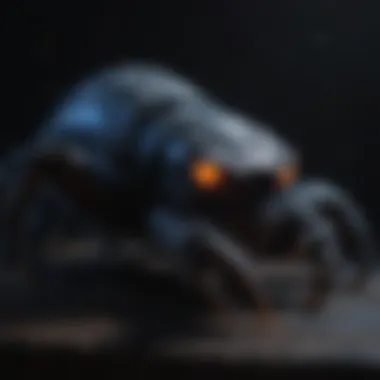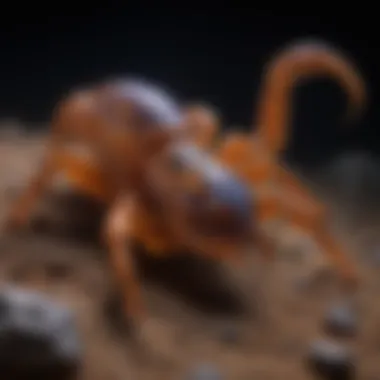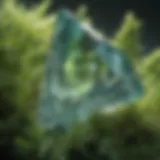Unveiling the Intriguing Secrets: Blacklight's Role in Scorpion Detection


Rock and Fossil Identification
Diving into the world of scorpion detection leads us to explore the crucial aspect of rock and fossil identification. Understanding the types of rocks and fossils is paramount when it comes to differentiating scorpion habitats and potential hiding spots. By recognizing the characteristics unique to each type, collectors can enhance their ability to locate scorpions effectively. Utilizing specialized tools for identification, such as magnifying lenses and mineral testers, further refines the process, pinpointing specific rock formations where scorpions are likely to thrive.
Blacklight Detection Techniques
Transitioning from rock and fossil identification, we immerse ourselves in the innovative world of applying blacklight for scorpion detection. Blacklight, also known as UV light, unveils scorpions' hidden presence through their distinctive fluorescence reaction. Delving into the science behind this phenomenon provides invaluable insights for collectors seeking to employ this cutting-edge technique. By harnessing the power of blacklight, enthusiasts can revolutionize the way they track and detect scorpions, making their experience both educational and rewarding.
Introduction to Blacklight
Blacklight, a key element in the realm of scorpion detection, serves as a vital tool in unveiling the mysteries of these elusive creatures through their unique fluorescence. This section delves into the fundamental aspects of blacklight, including its significance in detecting scorpions and its application in innovative techniques. By understanding the essence of blacklight, readers will grasp the essential role it plays in shedding light on the hidden world of scorpions, enhancing our ability to detect them effectively and efficiently.
Understanding Blacklight
Definition of Blacklight
Blacklight, also known as UV light, stands out for its ability to reveal fluorescence in scorpions. This distinct quality allows scorpions to be detected through the glow they emit when exposed to blacklight. The specific wavelength of blacklight triggers fluorescence in scorpions, making them visible in the dark. This characteristic makes blacklight a crucial tool in scorpion detection, offering a unique way to identify these nocturnal creatures effortlessly.
Wavelengths of Blacklight
The wavelengths of blacklight, mainly ultraviolet (UV) light, play a crucial role in interacting with scorpions' exoskeletons and inducing fluorescence. The specific UV wavelengths emitted by blacklight are optimized to excite scorpion proteins, causing them to glow distinctly under UV light. This targeted wavelength range enhances the visibility of scorpions, making them easier to detect and study in various environments. The strategic use of UV wavelengths in blacklight technology contributes significantly to the efficiency and accuracy of scorpion detection processes.
Properties of Ultraviolet Light
Ultraviolet light, a component of blacklight, possesses unique properties that make it ideal for illuminating scorpions. UV light has a shorter wavelength than visible light, allowing it to penetrate scorpions' exoskeletons and reveal their fluorescence. This property enables scorpion detection to be non-invasive, as UV light can highlight scorpions without disturbing their natural behavior. The distinctive properties of UV light in blacklight technology enhance the efficacy of scorpion detection, making it a versatile and powerful tool for researchers and enthusiasts alike.
Scorpion Detection: The Need for Innovation


Challenges in Scorpion Detection
Challenges in scorpion detection stem from their nocturnal habits and cryptic nature, making them elusive to identify using traditional methods. The ability of scorpions to hide in various terrains, coupled with their adaptive camouflage, poses challenges for accurately locating and studying them in their natural habitats. Innovations in detection techniques, such as blacklight technology, provide solutions to these challenges by offering a reliable method to visualize scorpions clearly in different settings.
Advantages of Blacklight Technology
Blacklight technology presents numerous advantages in scorpion detection, including its ability to reveal hidden scorpions through fluorescence. The unique fluorescence exhibited by scorpions under UV light simplifies the process of locating and studying them, enhancing research efforts and conservation initiatives. The innovation brought by blacklight technology in scorpion detection offers a non-invasive and effective approach to understanding these intriguing creatures, emphasizing the importance of incorporating technological advancements in wildlife research and preservation efforts.
The Science Behind Scorpion Fluorescence
In the realm of scorpion detection, understanding the intricate mechanisms of scorpion fluorescence is paramount. This section delves deep into the fascinating world of how scorpions interact with ultraviolet (UV) light, showcasing the remarkable phenomenon that sets them apart. By shedding light on the science behind scorpion fluorescence, readers will grasp the significance of this topic in unraveling the mysteries of scorpion detection.
Fluorescence Phenomenon
How Scorpions Fluoresce
A crucial aspect of scorpion fluorescence is how these enigmatic creatures emit a mesmerizing glow when exposed to UV light. This unique ability stems from specialized cells in their exoskeleton that react to specific wavelengths of light, causing a fluorescence effect. The novel way in which scorpions fluoresce serves as a key tool in distinguishing them in their natural habitats. Delving into the intricacies of how scorpions fluoresce offers invaluable insights into the mechanisms at play and the practical implications for detection methods.
Biological Significance
The biological significance of scorpion fluorescence extends beyond mere illumination under UV light. It serves as a crucial adaptation that aids in camouflage, attracting prey, and even potential mate selection. Understanding the evolutionary advantages of this fluorescence phenomenon provides a holistic view of scorpions' survival strategies and ecological roles. By exploring the biological significance of scorpion fluorescence, this article uncovers a deeper layer of complexity within these fascinating arachnids.
Blacklight and Scorpion Detection
Interaction of UV Light with Scorpion Exoskeleton
An essential element in the detection of scorpions is the interaction of UV light with their exoskeleton. The ultraviolet light causes certain compounds within the scorpion's exoskeleton to fluoresce, emitting a distinct glow that sets them apart from their surroundings. This unique interaction acts as a signature characteristic for identifying scorpions in various environments, making it a valuable tool for researchers and enthusiasts alike. Exploring the intricate dynamic between UV light and the scorpion exoskeleton unveils a world of hidden fluorescence waiting to be discovered.


Benefits of Fluorescence in Detection
The benefits of fluorescence in scorpion detection are manifold, ranging from increased visibility in low-light conditions to the non-invasive nature of UV light exposure. By harnessing the power of fluorescence, researchers can spot scorpions with greater accuracy and efficiency, minimizing disturbance to their habitats. This section highlights how fluorescence enhances detection capabilities, paving the way for innovative approaches in studying and conserving scorpion populations.
Implementing Blacklight for Scorpion Detection
Implementing Blacklight for Scorpion Detection is a pivotal aspect within the comprehensive spectrum of utilizing blacklight for scorpion identification. In this article, it serves as a crucial juncture bridging theoretical knowledge with practical application, accentuating various elements essential in the successful implementation of blacklight technology for scorpion detection. The significance of this topic lies in its ability to shed light on how practitioners in the field can leverage blacklight technology effectively to detect scorpions, thereby enhancing safety measures and environmental awareness.
Practical Applications
Outdoor Scorpion Detection
Outdoor Scorpion Detection plays a fundamental role in the context of scorpion identification, particularly in natural habitats where these arachnids thrive. Highlighting the unique challenges posed by outdoor environments, this technique contributes to the overarching goal of comprehensive scorpion detection. Its key characteristic lies in the ability to detect scorpions in their natural habitats, offering crucial insights into their behaviors and population dynamics. This method is a preferred choice for researchers and enthusiasts in this field due to its effectiveness in identifying scorpions in open environments. The main advantage of Outdoor Scorpion Detection is its non-invasive approach, allowing for minimal disruption to the scorpion's habitat while providing valuable data for research purposes.
Indoor Scorpion Detection
Indoor Scorpion Detection, on the other hand, caters to the need for scorpion identification within enclosed spaces such as homes, buildings, or laboratories. This method addresses the unique challenges associated with indoor environments and emphasizes the importance of identifying scorpions in human-inhabited spaces. The key characteristic of Indoor Scorpion Detection lies in its focus on areas where scorpions may pose a threat to individuals, warranting swift and accurate detection methods. Its popularity stems from the necessity of ensuring safety within indoor spaces, making it a vital choice for scorpion detection strategies. While Indoor Scorpion Detection offers the advantage of targeted identification, its main limitation may revolve around the need for careful handling to prevent scorpions from dispersing in indoor settings.
Equipment and Techniques
Types of Blacklight Devices
Understanding the diverse array of Types of Blacklight Devices is crucial for practitioners aiming to optimize scorpion detection processes. Each type of device contributes uniquely to the efficiency and accuracy of scorpion identification, highlighting the versatility of blacklight technology in this context. The key characteristic of these devices lies in their ability to emit specific wavelengths of UV light, essential for stimulating scorpion fluorescence. Their popularity stems from their portability and ease of use, making them a preferred choice for researchers and professionals in the field. The unique feature of Types of Blacklight Devices lies in their capacity to reveal fluorescence patterns distinctive to scorpions, aiding in precise identification.
Best Practices for Effective Detection
Implementing Best Practices for Effective Detection enhances the overall efficacy of scorpion identification using blacklight technology. By following established protocols and guidelines, practitioners can maximize the accuracy and reliability of scorpion detection processes, ensuring precise results. The key characteristic of this practice is its emphasis on standardized procedures that streamline detection efforts and minimize errors. Its popularity stems from the demonstrable increase in detection sensitivity and efficiency when these practices are implemented. The unique feature of Best Practices for Effective Detection lies in their ability to minimize false positives and negatives, thereby enhancing the overall reliability of scorpion identification techniques.


Benefits and Limitations of Blacklight Detection
In the realm of scorpion detection, the topic of benefits and limitations of blacklight detection plays a crucial role in enhancing our understanding of this innovative technique. When delving into the advantages, it becomes evident that blacklight detection offers increased sensitivity, which is a significant factor in identifying scorpions with precision. The heightened sensitivity of blacklight enables collectors in the rock and fossil field to detect scorpions more accurately, contributing to the effectiveness of their work.
Furthermore, blacklight serves as a non-invasive method for scorpion detection, allowing for a less intrusive approach to identifying these creatures. This non-invasive nature is particularly beneficial for rock and fossil collectors who aim to study scorpions without causing harm or disruption to their natural habitat. It provides a gentle yet highly effective means of detecting scorpions, aligning perfectly with the ethos of conservation and preservation.
On the flip side, it's essential to consider the limitations of blacklight detection. While it offers increased sensitivity, there are constraints to its effectiveness, such as potential false positives or limitations in detecting scorpions under certain conditions. Understanding these limitations is crucial for collectors to interpret results accurately and make informed decisions during their endeavors.
In addition, environmental factors play a significant role in impacting the accuracy of blacklight detection. Issues such as ambient light levels, humidity, and temperature variations can affect the efficacy of blacklight in detecting scorpions. By recognizing and addressing these environmental influences, collectors can optimize their detection processes and improve the overall reliability of their findings. It's essential to navigate through these challenges effectively to ensure the success of scorpion detection using blacklight technology.
Future Implications and Research Directions
In the realm of scorpion detection, understanding future implications and research directions is crucial for advancing this innovative technology. As the industry continues to evolve, researchers are constantly exploring new avenues for enhancing detection methods and improving accuracy. In this article, we shed light on the significance of future implications and research directions within the context of blacklight for scorpion detection.
Innovations in Scorpion Detection
Emerging Technologies
Delving into the realm of emerging technologies, we encounter cutting-edge advancements that are revolutionizing scorpion detection. One such innovation is the development of specialized UV light sensors that can precisely pinpoint scorpions based on their unique fluorescence patterns. These sensors utilize advanced algorithms to differentiate scorpion fluorescence from ambient light, thereby significantly improving detection reliability. The key characteristic of these emerging technologies lies in their unprecedented level of sensitivity, allowing for more accurate and efficient scorpion identification. Despite their benefits, these technologies may pose challenges such as cost implications and calibration requirements, factors to consider when incorporating them into scorpion detection protocols.
Potential Advancements
Exploring potential advancements in scorpion detection unveils a myriad of opportunities for enhancing current practices. One noteworthy advancement is the integration of machine learning algorithms to interpret fluorescence data and streamline detection processes. By leveraging artificial intelligence capabilities, researchers can extract valuable insights from fluorescence patterns, enabling faster and more precise scorpion identification. The unique feature of these potential advancements lies in their ability to adapt and improve over time, making them a valuable asset for enhancing detection capabilities. However, considerations regarding data privacy and algorithm bias must be addressed to fully capitalize on the advantages of these advancements within the scope of scorpion detection.
Uncovering New Insights
Unexplored Areas of Research
Venturing into unexplored areas of research opens doors to novel possibilities for advancing scorpion detection. One intriguing area of exploration is the study of scorpion venom composition and its interaction with UV light, shedding light on potential variations in fluorescence patterns among different scorpion species. Understanding these nuances could lead to the development of targeted detection methods tailored to specific venom compositions, enhancing overall detection accuracy. The key characteristic of these unexplored areas of research is their potential to unveil hidden complexities within scorpion fluorescence, offering new avenues for innovation.
Collaborative Opportunities
Embracing collaborative opportunities in scorpion detection fosters a culture of knowledge exchange and mutual growth. By fostering partnerships between researchers, technology developers, and environmental agencies, collaborative initiatives can drive advancements in detection techniques and promote shared learning. The key characteristic of these opportunities lies in their ability to leverage diverse expertise towards a common goal, enabling synergistic solutions and holistic approaches to scorpion detection challenges. However, careful navigation of intellectual property rights and resource allocation is essential to maximize the benefits of collaboration in the dynamic landscape of scorpion detection research.







